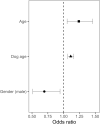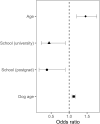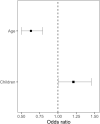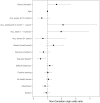Investigation into owner-reported differences between dogs born in versus imported into Canada
- PMID: 35704562
- PMCID: PMC9200170
- DOI: 10.1371/journal.pone.0268885
Investigation into owner-reported differences between dogs born in versus imported into Canada
Abstract
Over 1 million dogs are imported into the United States and roughly 340,000 dogs into the United Kingdom yearly. Although the official number of dogs arriving to Canada is currently unknown, local animal professionals estimate that thousands of dogs are imported into Canada each year. Dog importation may be increasing globally while regulation and surveillance are still limited, resulting in concerns for the health and welfare of imported dogs. To date, few studies have investigated how the source location of dogs influences the owner-dog relationship. The current report presents two independent studies that were conducted to assess whether owners of imported dogs reported a poorer owner-dog relationships compared to owners of Canadian-born dogs. In both studies, an online survey was distributed to dog owners (Study 1: n = 803; Study 2: n = 878) in British Columbia, Canada, containing questions on various aspects of the owner-dog relationship. The first study included questions from the Lexington Attachment to Pets Scale, Canine Behavioral Assessment and Research Questionnaire, Human-Animal Bond questionnaire, Monash Dog Owner Relationship Scale, and constructed questions about training methods, expectations, and health. The second study was comprised of original questions assessing difficult behaviour, training practices, health, attachment, and perceived level of burden of owning a dog. Both studies found no evidence of a poorer owner-dog relationship in non-Canadian-sourced dogs. In fact, owners of Canadian-sourced dogs used harsh training methods more frequently and had higher expectations for their dog. While no signs of poorer owner-dog relationship in non-Canadian-sourced dogs were found, future research should continue the investigation of age, health, and backgrounds of incoming dogs.
Conflict of interest statement
The authors have declared that no competing interests exist.
Figures




Similar articles
-
Lasting lockdown love? Problem behaviour and pandemic and non-pandemic related risk factors influencing the owner-dog relationship in a UK cohort of dogs reaching early adulthood.PLoS One. 2025 Feb 12;20(2):e0316166. doi: 10.1371/journal.pone.0316166. eCollection 2025. PLoS One. 2025. PMID: 39937701 Free PMC article.
-
Great expectations, inconvenient truths, and the paradoxes of the dog-owner relationship for owners of brachycephalic dogs.PLoS One. 2019 Jul 19;14(7):e0219918. doi: 10.1371/journal.pone.0219918. eCollection 2019. PLoS One. 2019. PMID: 31323057 Free PMC article.
-
The role of dogs is associated with owner management practices and characteristics, but not with perceived canine behaviour problems.Sci Rep. 2024 Nov 12;14(1):27548. doi: 10.1038/s41598-024-77400-y. Sci Rep. 2024. PMID: 39532970 Free PMC article.
-
Lead pulling as a welfare concern in pet dogs: What can veterinary professionals learn from current research?Vet Rec. 2022 Nov;191(10):e1627. doi: 10.1002/vetr.1627. Epub 2022 May 12. Vet Rec. 2022. PMID: 35546517 Review.
-
The Welfare of Dogs as an Aspect of the Human-Dog Bond: A Scoping Review.Animals (Basel). 2024 Jul 5;14(13):1985. doi: 10.3390/ani14131985. Animals (Basel). 2024. PMID: 38998097 Free PMC article.
Cited by
-
Reasons for Guardian-Relinquishment of Dogs to Shelters: Animal and Regional Predictors in British Columbia, Canada.Front Vet Sci. 2022 Apr 14;9:857634. doi: 10.3389/fvets.2022.857634. eCollection 2022. Front Vet Sci. 2022. PMID: 35498734 Free PMC article.
-
A Study on the Attachment to Pets Among Owners of Cats and Dogs Using the Lexington Attachment to Pets Scale (LAPS) in the Basque Country.Animals (Basel). 2025 Jan 1;15(1):76. doi: 10.3390/ani15010076. Animals (Basel). 2025. PMID: 39795019 Free PMC article.
-
"It's my calling", Canadian dog rescuers' motives and experiences for engaging in international dog rescue efforts.PLoS One. 2024 May 31;19(5):e0300104. doi: 10.1371/journal.pone.0300104. eCollection 2024. PLoS One. 2024. PMID: 38820400 Free PMC article.
References
-
- Centers for Disease Control and Prevention. Guidance Regarding Agency Interpretation of “Rabies-Free” as It Relates to the Importation of Dogs Into the United States. 2019. https://www.federalregister.gov/documents/2019/01/31/2019-00506/guidance...
-
- The Kennel Club. Puppy imports. https://www.thekennelclub.org.uk/about-us/campaigns/puppy-imports/
-
- Dogs Trust. Dogs Trust fears no end in sight for cruel puppy trade. 2019. https://www.dogstrust.org.uk/latest/puppy-smuggling/dogs-trust-fears-no-...
-
- United States Department of Agriculture. Report on the Importation of Live Dogs into the United States. 2019. https://www.naiaonline.org/uploads/WhitePapers/USDA_DogImportReport6-25-...
Publication types
MeSH terms
LinkOut - more resources
Full Text Sources

